If you’ve ever managed the peer review process for conference abstract submissions, you know it can feel like a never-ending headache.
Assigning abstracts to the right reviewers can easily eat up days, or even weeks of your time, especially when you’re tangled up in endless email chains and messy spreadsheets.
And even if you’ve invested in software, you may still face administrative nightmares like convoluted reporting, a clunky reviewer portal that frustrates your respected experts, or abstracts getting mistakenly assigned to the wrong reviewers.
These challenges can prevent you or your conference administrators from focusing on work that actually matters: delivering a high-quality conference experience for your attendees and speakers, fostering education, and ensuring scientific or academic integrity.
In this blog post, we’re sharing actionable tips to optimize your peer review process so that you can get out of the weeds and redirect your time and energy to enhancing your conference and engaging your members.
Tips for Optimizing the Peer Review Process
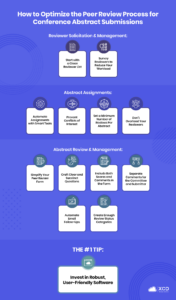
1. Start with a Clean Reviewer List
Before diving into the review process, make sure your reviewer list is organized by topic area. Align these topic areas with options on the abstract submission form to simplify assignments later on. A clean, well-categorized reviewer list is your first step toward a seamless peer review process.
2. Survey Reviewers to Reduce Your Workload
If possible, send a survey to your reviewers asking if they’re willing to participate this year and which categories they’re comfortable reviewing. This proactive step will help you organize your reviewer pool efficiently and ensure you’re assigning abstracts to those who are ready and eager to contribute.
3. Automate Assignments with Smart Tools
Manual assignments are tedious and prone to errors. Invest in a tool that can automatically assign abstracts to peer reviewers based on the topic area or track that they indicated in the survey. Let technology handle the heavy lifting so you can focus on more important tasks.
(P.S. X-CD’s peer review software enables this automation, but more on this later!)
4. Prevent Conflicts of Interest
Avoid potential conflicts by ensuring reviewers aren’t assigned abstracts they’re affiliated with or have personal biases toward.
5. Set a Minimum Number of Reviews Per Abstract
Quality matters, so establish a minimum number of reviews per abstract to ensure consistent and thorough feedback. This will help you maintain the integrity of your conference and provide submitters with a comprehensive assessment of their work.
6. Don’t Overload Your Reviewers
Keep your reviewers happy by setting a reasonable maximum number of assignments per reviewer. An unmanageable load can lead to rushed reviews and frustrated experts, so make sure they’re not overwhelmed.
7. Simplify Your Peer Review Form
Ensure your peer review form is structured properly. Control the display of review fields based on related abstract submission fields and ask as many questions as you need without being redundant or irrelevant. Reviewers appreciate a streamlined form that gets to the point.
8. Craft Clear and Succinct Questions
Succinct questions lead to clearer answers. Keep your review questions brief and to the point to ensure reviewers understand what’s being asked and can respond quickly.
9. Include Both Scores and Reviewers’ Comments in the Form
A good review form includes both scoring and comments fields. Scoring provides a quick assessment, while reviewers’ comments offer valuable qualitative feedback for the review committee or submitters. Make sure your form includes both to ensure that everyone has the context necessary to make decisions and understand the score.
10. Separate Comments for the Committee and Submitter
If you are going to share reviewer comments with the submitters, it is best practice to make this abundantly clear to the reviewer. We suggest creating two separate comments fields and labeling them clearly: 1) Comments for the Review Committee, and 2) Comments for the Authors. This way, the reviewer can phrase their comments more gently, and be constructive to the author.
11. Automate Email Follow-Ups
Stay on top of pending reviews by automating follow-up emails to your reviewers. Schedule reminders throughout the review process and avoid leaving this task until the last minute. Timely follow-ups keep reviewers engaged and on track.
12. Create Enough Review Status Categories
Think beyond the final “accepted” or “rejected” status. Create as many review status categories as you need, each with its own unique email template. An abstract can go through multiple rounds of review and resubmission, so make sure your status categories provide you the flexibility to manage the full process.
13. Invest in Robust, User-Friendly Software
Don’t let outdated software or legacy manual processes hold you back. Invest in a peer review system that’s robust, user-friendly, and can handle the intricacies of your conference review process.
For example, X-CD’s peer review software simplifies abstract assignments, prevents conflicts, and automates follow-ups so you can focus on delivering a high-quality conference.
A Look at the Peer Review Process with X-CD
Streamlining the process of peer review for your conference doesn’t have to be a daunting task. Here’s a closer look at how X-CD’s peer review software simplifies the entire journey, from reviewer solicitation to abstract review.
1. Reviewer Solicitation: Managing Your Reviewer Pool
Building and managing your reviewer pool effectively is crucial for ensuring fair abstract reviews and cutting out unnecessary, time-intensive admin tasks. With X-CD, conference organizers can easily gather information on reviewer preferences and expertise, ensuring each reviewer is assigned to the right abstracts:
- Reviewer Invitations: Send a personalized sign-up form or invitation link to a curated group of prospective peer reviewers.
- Preference Selection: Reviewers can select their preferred topic areas from the conference’s list, ensuring assignments align with their expertise.
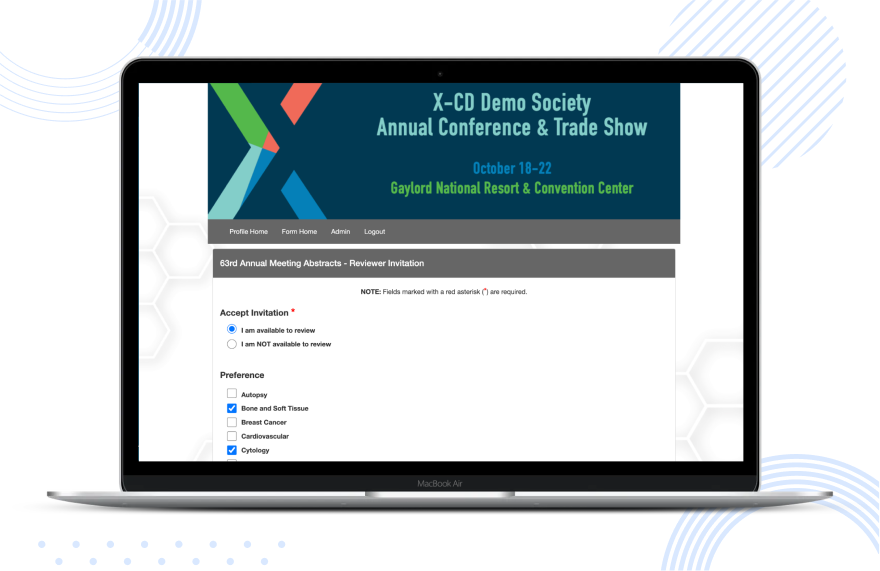
- Reviewer Pool: A reviewer pool is populated based on reviewer sign-up form submissions.
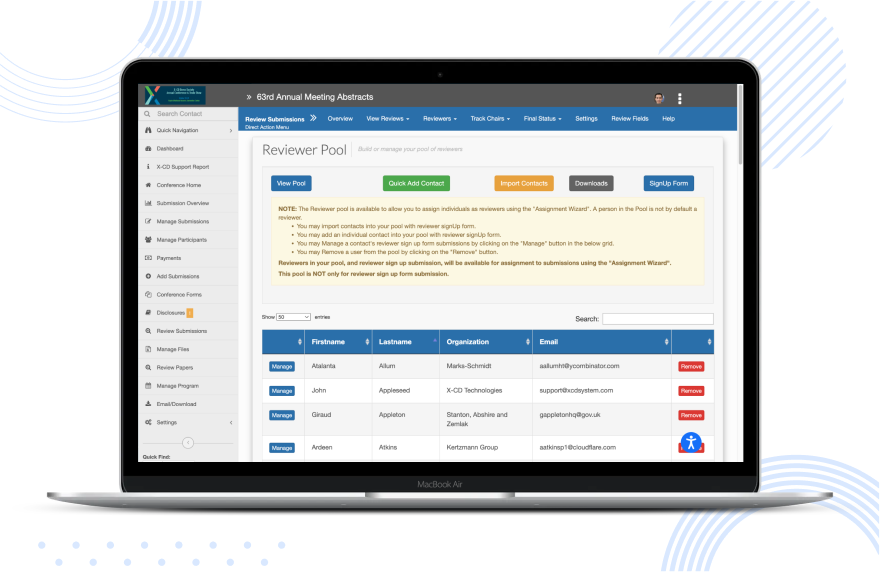
2. Abstract Assignments: Matching the Right Experts to Submissions
Without an automated system, conference administrators may find themselves manually cross-referencing email chains and spreadsheets to ensure that each abstract is assigned to a reviewer with relevant expertise—a task that can eat up weeks of time for large conferences. Assigning abstracts to the right reviewers automatically is where X-CD’s Assignment Wizard shines.
Here are some of the features that help conference organizers achieve accurate and efficient assignments:
- Assignment Wizard: Automatically match abstracts to reviewers based on expertise and criteria like:
- Minimum number of reviews per submission.
- Maximum number of assignments per reviewer.
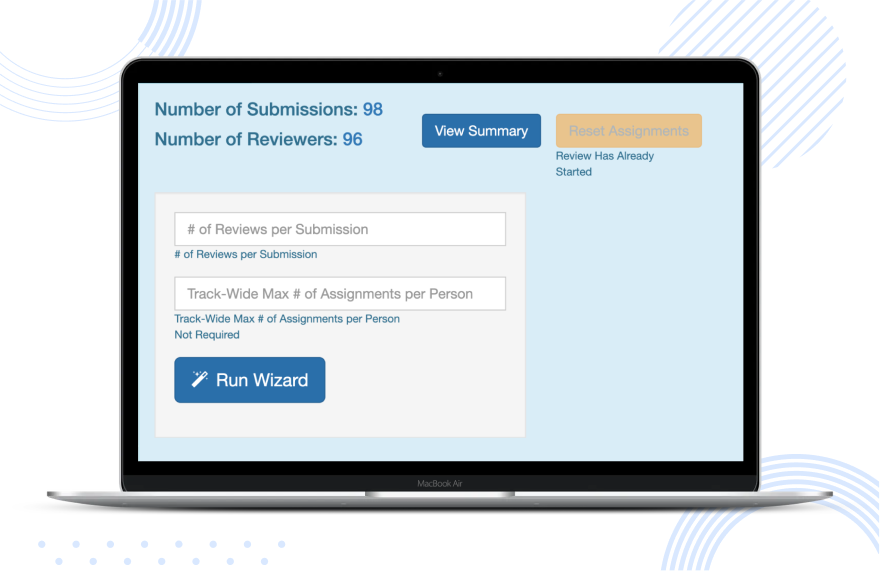
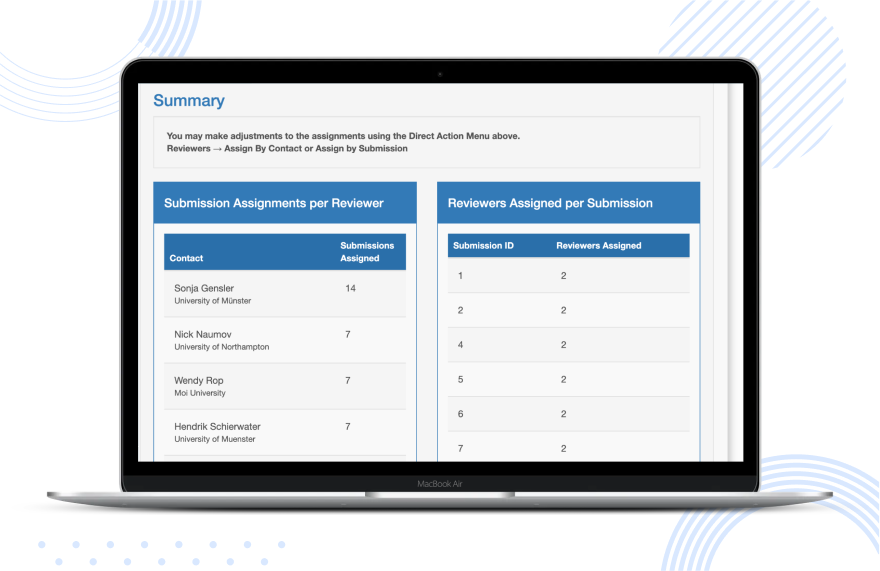
- Automated Reminders and Nudges: Set up automated reminders for reviewers with incomplete assignments and nudge all reviewers who have yet to review abstracts in just a few clicks.
- Flexible Adjustments: Manually adjust or reassign abstracts when needed to ensure a smooth review process.
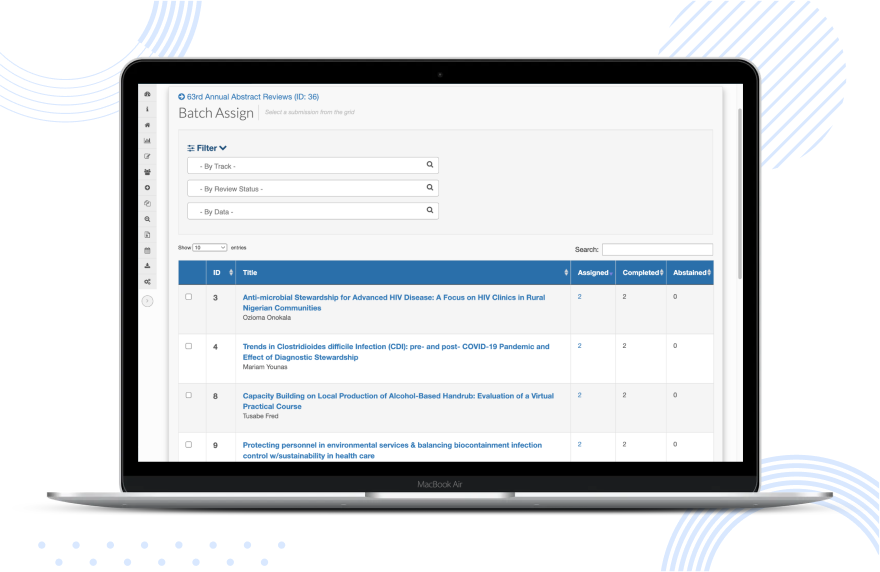
3. Abstract Review: Providing Fair Scores & Thorough Assessments
Without a robust tool like X-CD’s peer review software, you may have run into some of the following challenges:
- Disorganized Review Forms: Reviewers may receive poorly structured or inconsistent forms, leading to incomplete or irrelevant feedback.
- Lack of Transparency: Authors may not receive constructive feedback due to disorganized reviewer comments or lack of clarity on review criteria.
- Manual Communication: Manually notifying authors of their acceptance or rejection can lead to delays and inconsistencies in messaging.
- Difficulty Managing Revisions: Tracking resubmissions and ensuring fair reevaluation is cumbersome and prone to errors.
- No Centralized Scoring System: Administrators often rely on spreadsheets to tally scores, which is time-consuming and prone to data entry errors.
With X-CD’s Peer Review Module, the abstract review process becomes a streamlined, efficient, and transparent experience:
- Blind or Not Blind Peer Review Model: Choose to set reviews as blind or not blind, ensuring a fair process tailored to your conference’s needs.
- Custom Review Forms: Reviewers score abstracts using your conference’s custom review form, designed to meet specific criteria. This ensures consistent and relevant feedback:
- Scoring questions help quantify the review results.
- Comment fields allow for qualitative feedback to authors and the program committee.
- Program Committee Review: The program committee or organizers can easily analyze peer review reports to determine which abstracts and speakers should be featured and in what session.
- Automated Rejection Letters: Automatically send rejection letters to submitters who receive the lowest scores, ensuring timely communication.
- Final Status Notifications: Set final statuses and automatically notify presenters of their final acceptance or rejection with customizable placeholders (hotkeys) for quick and simple communication.
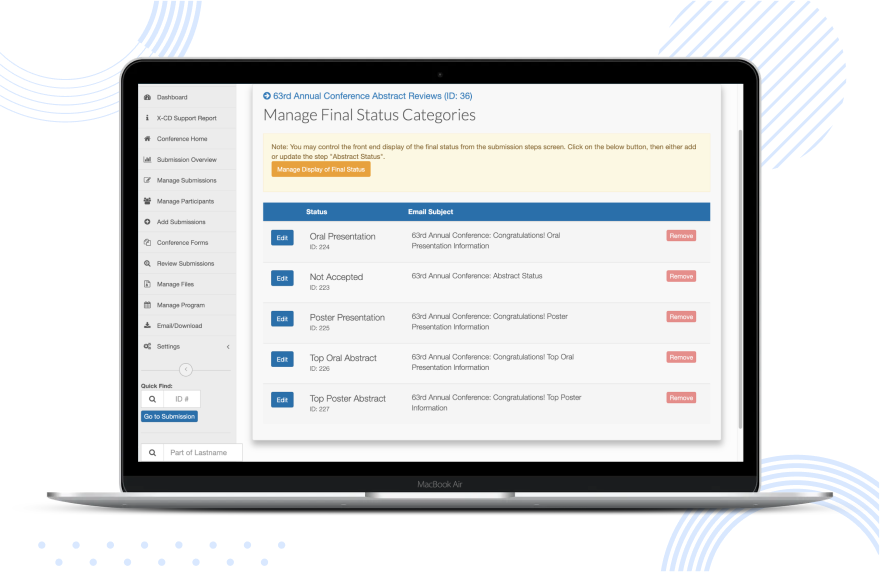
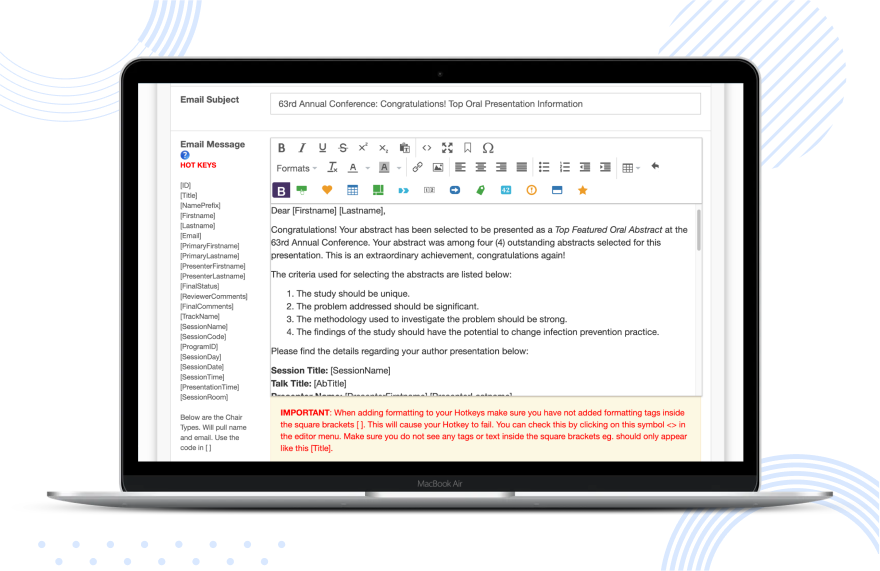
- Resubmissions and Feedback: Rejected presenters can review constructive feedback and resubmit their work if necessary.
Streamline Your Peer Review Procedure from Start to Finish
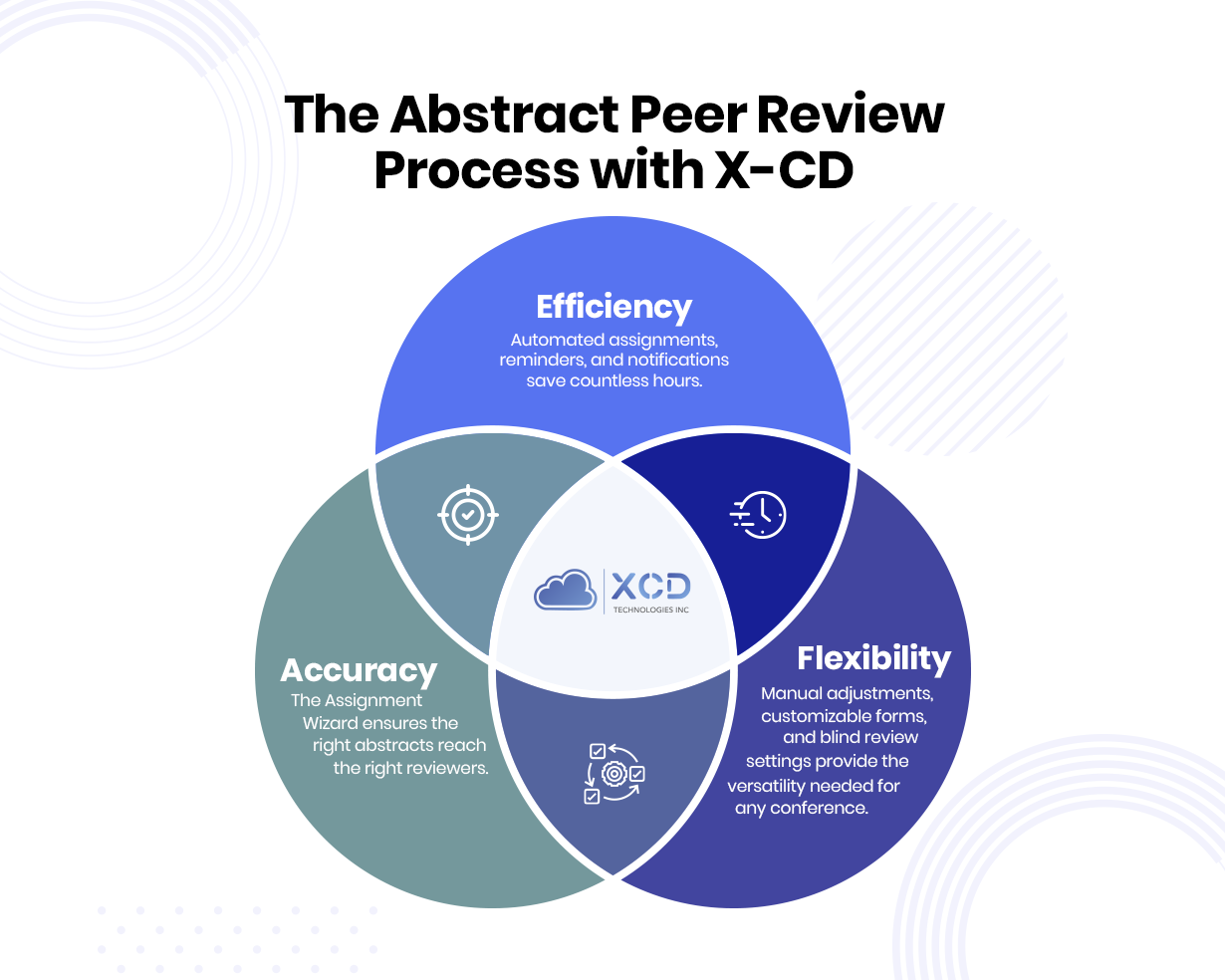
With X-CD’s Peer review software, conference organizers can take full control of the peer review process, automating repetitive tasks, minimizing errors, and focusing on delivering a high-quality conference.
No more juggling spreadsheets or struggling with clunky systems—X-CD has you covered from reviewer solicitation to final decisions.
Request a demo today to see first-hand how X-CD can help you streamline your peer review process.




